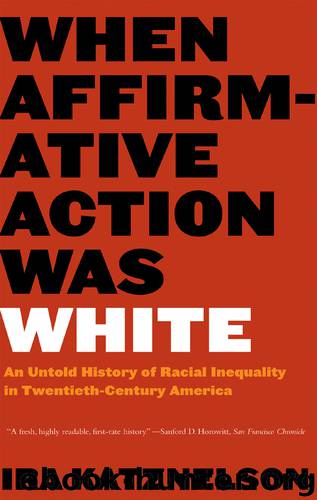When Affirmative Action Was White by Ira Katznelson

Author:Ira Katznelson
Language: eng
Format: epub, mobi
Publisher: W. W. Norton & Company
III
BLACKS ALSO FACED STRUCTURAL and demographic disadvantages—even if institutionalized racism had not been a key feature of the GI Bill, and even if it were the case, as the VA reported, that blacks in their twenties and thirties had been disproportionately underrepresented in the armed forces. A significantly lower portion had qualified for service based on the military’s various tests for physical health, literacy, and aptitude. Throughout the Second World War, the rejection rate for blacks remained a good deal higher than that for whites. In all, only half of blacks in the relevant age group served in the military as compared to three out of every four whites.63 Even in the period when manpower needs were most acute, black enlistments stayed at about 75–80 percent of the white proportion in the relevant pool from which soldiers were drawn.64
It is important to underscore, however, that this difference in eligibility was a good deal less significant in shaping the racial qualities of the GI Bill than the way in which its benefits were distributed by the nearly all-white decentralized apparatus charged with administration. Nowhere was this more true than in the realm of education. Even outside the South, black access to primarily white colleges and universities remained limited. De facto quotas and, in some cases, high selectivity closed these schools to the vast majority of blacks qualified for higher education. A Princeton poll conducted by a campus newspaper in 1942 discovered that nearly two in every three students opposed the admission of blacks, while those who favored a right of entry did so under the stipulation of limitations that “included such demands as a ban from Prospect Street, much higher standards than for white people, and definite quotas.”65 Of the nine thousand students at the University of Pennsylvania in 1946 (which, along with Columbia University, had the least restrictive policies in the Ivy League), only forty-six were black.66 Writing about non-southern institutions, President Truman’s Committee on Civil Rights found in 1948:
Download
When Affirmative Action Was White by Ira Katznelson.mobi
This site does not store any files on its server. We only index and link to content provided by other sites. Please contact the content providers to delete copyright contents if any and email us, we'll remove relevant links or contents immediately.
| Anthropology | Archaeology |
| Philosophy | Politics & Government |
| Social Sciences | Sociology |
| Women's Studies |
Nudge - Improving Decisions about Health, Wealth, and Happiness by Thaler Sunstein(6647)
iGen by Jean M. Twenge(4708)
The Fire Next Time by James Baldwin(4357)
Adulting by Kelly Williams Brown(3687)
The Sports Rules Book by Human Kinetics(3602)
The Hacking of the American Mind by Robert H. Lustig(3591)
The Ethical Slut by Janet W. Hardy(3519)
Captivate by Vanessa Van Edwards(3312)
Mummy Knew by Lisa James(3176)
In a Sunburned Country by Bill Bryson(2957)
The Worm at the Core by Sheldon Solomon(2934)
Ants Among Elephants by Sujatha Gidla(2932)
Suicide: A Study in Sociology by Emile Durkheim(2617)
The Slow Fix: Solve Problems, Work Smarter, and Live Better In a World Addicted to Speed by Carl Honore(2580)
Humans of New York by Brandon Stanton(2385)
Handbook of Forensic Sociology and Psychology by Stephen J. Morewitz & Mark L. Goldstein(2381)
Blackwell Companion to Sociology, The by Judith R. Blau(2321)
The Happy Hooker by Xaviera Hollander(2278)
Outliers by Malcolm Gladwell(2266)
